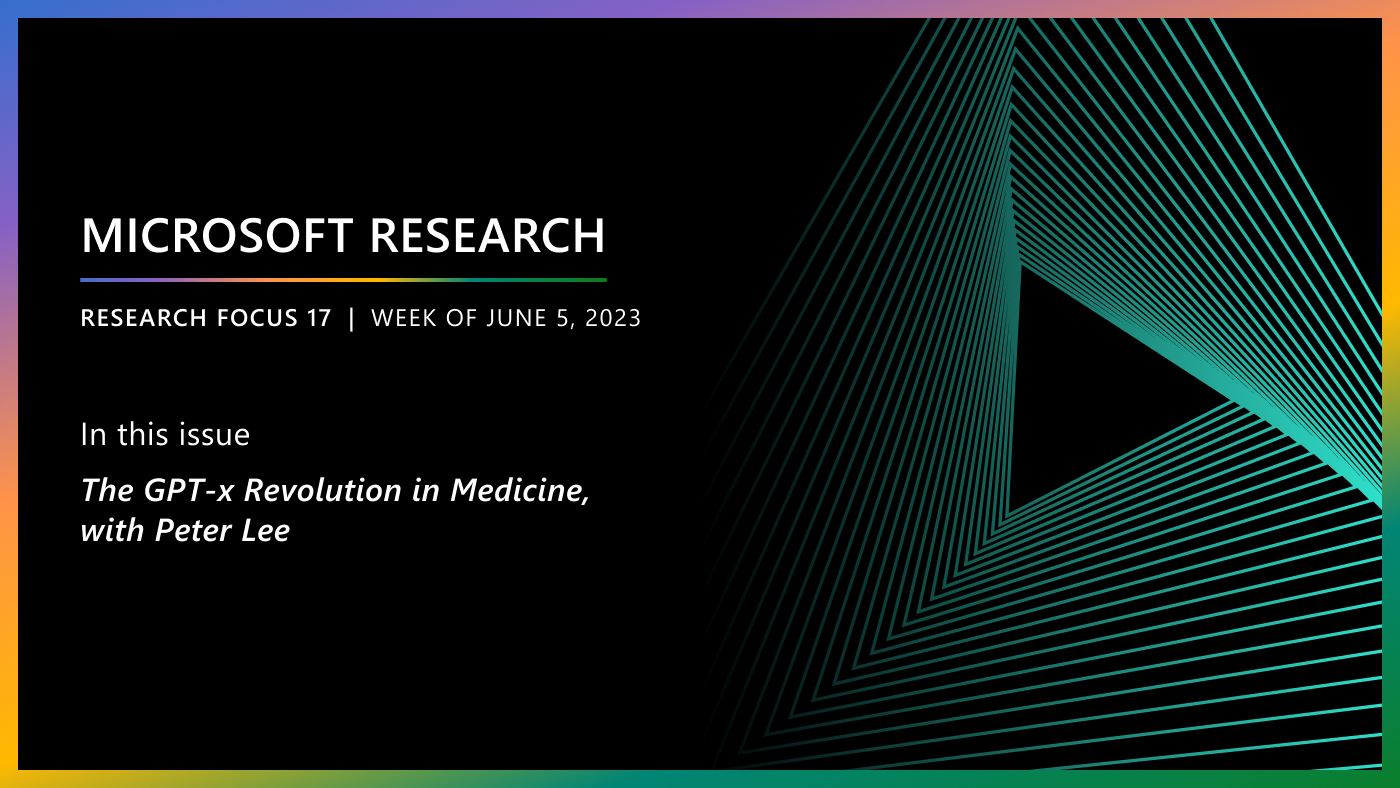Welcome to Research Focus, a series of blog posts that highlights notable publications, events, code/datasets, new hires and other milestones from across the research community at Microsoft.

NEW RESEARCH
Can Large Language Models Transform Natural Language Intent into Formal Method Postconditions?
Informal natural language that describes code functionality, such as code comments or function documentation, may contain substantial information about a program’s intent. However, there is no guarantee that a program’s implementation aligns with its natural language documentation. In the case of a conflict, leveraging information in code-adjacent natural language has the potential to enhance fault localization, debugging, and code trustworthiness. However, this information is often underutilized, due to the inherent ambiguity of natural language which makes natural language intent challenging to check programmatically. The “emergent abilities” of large language models (LLMs) have the potential to facilitate the translation of natural language intent to programmatically checkable assertions. However, due to a lack of benchmarks and evaluation metrics, it is unclear if LLMs can correctly translate informal natural language specifications into formal specifications that match programmer intent—and whether such translation could be useful in practice.
In a new paper: Can Large Language Models Transform Natural Language Intent into Formal Method Postconditions? (opens in new tab), researchers from Microsoft describe nl2postcond, the problem leveraging LLMs for transforming informal natural language to formal method postconditions, expressed as program assertions. The paper, to be presented at the upcoming ACM International Conference on the Foundations of Software Engineering (opens in new tab), introduces and validates metrics to measure and compare different nl2postcond approaches, using the correctness and discriminative power of generated postconditions. The researchers show that nl2postcond via LLMs has the potential to be helpful in practice by demonstrating that LLM-generated specifications can be used to discover historical bugs in real-world projects.
NEW RESEARCH
Semantically Aligned Question and Code Generation for Automated Insight Generation
People who work with data, like engineers, analysts, and data scientists, often must manually look through data to find valuable insights or write complex scripts to automate exploration of the data. Automated insight generation provides these workers the opportunity to immediately glean insights about their data and identify valuable starting places for writing their exploration scripts. Unfortunately, automated insights produced by LLMs can sometimes generate code that does not correctly correspond (or align) to the insight. In a recent paper: Semantically Aligned Question and Code Generation for Automated Insight Generation (opens in new tab), researchers from Microsoft leverage the semantic knowledge of LLMs to generate targeted and insightful questions about data and the corresponding code to answer those questions. Through an empirical study on data from Open-WikiTable (opens in new tab), they then show that embeddings can be effectively used for filtering out semantically unaligned pairs of question and code. The research also shows that generating questions and code together yields more interesting and diverse insights about data.
NEW RESEARCH
Explaining CLIP’s performance disparities on data from blind/low vision users
AI-based applications hold the potential to assist people who are blind or low vision (BLV) with everyday visual tasks. However, human assistance is often required, due to the wide variety of assistance needed and varying quality of images available. Recent advances in large multi-modal models (LMMs) could potentially address these challenges, enabling a new era of automated visual assistance. Yet, little work has been done to evaluate how well LMMs perform on data from BLV users.
In a recent paper: Explaining CLIP’s performance disparities on data from blind/low vision users (opens in new tab), researchers from Microsoft and the World Bank address this issue by assessing CLIP (opens in new tab), a widely-used LMM with potential to underpin many assistive technologies. Testing 25 CLIP variants in a zero-shot classification task, their results show that disability objects, like guide canes and Braille displays, are recognized significantly less accurately than common objects, like TV remote controls and coffee mugs—in some cases by up to 28 percentage points difference.
The researchers perform an analysis of the captions in three large-scale datasets that are commonly used to train models like CLIP and show that BLV-related content (such as guide canes) is rarely mentioned. This is a potential reason for the large performance gaps. The researchers show that a few-shot learning approach with as little as five example images of a disability object can improve its ability to recognize that object, holding the potential to mitigate CLIP’s performance disparities for BLV users. They then discuss other possible mitigations.
Microsoft Research Blog
Microsoft Research Forum Episode 3: Globally inclusive and equitable AI, new use cases for AI, and more
In the latest episode of Microsoft Research Forum, researchers explored the importance of globally inclusive and equitable AI, shared updates on AutoGen and MatterGen, presented novel use cases for AI, including industrial applications and the potential of multimodal models to improve assistive technologies.
NEW RESEARCH
Closed-Form Bounds for DP-SGD against Record-level Inference
Privacy of training data is a central consideration when deploying machine learning (ML) models. Models trained with guarantees of differential privacy (DP) provably resist a wide range of attacks. Although it is possible to derive bounds, or safe limits, for specific privacy threats solely from DP guarantees, meaningful bounds require impractically small privacy budgets, which results in a large loss in utility.
In a recent paper: Closed-Form Bounds for DP-SGD against Record-level Inference, researchers from Microsoft present a new approach to quantify the privacy of ML models against membership inference (inferring whether a data record is in the training data) and attribute inference (reconstructing partial information about a record) without the indirection through DP. They focus on the popular DP-SGD algorithm, which they model as an information theoretic channel whose inputs are the secrets that an attacker wants to infer (e.g., membership of a data record) and whose outputs are the intermediate model parameters produced by iterative optimization. They obtain closed-form bounds for membership inference that match state-of-the-art techniques but are orders of magnitude faster to compute. They also present the first algorithm to produce data-dependent bounds against attribute inference. Compared to bounds computed indirectly through numerical DP budget accountants, these bounds provide a tighter characterization of the privacy risk of deploying an ML model trained on a specific dataset. This research provides a direct, interpretable, and practical way to evaluate the privacy of trained models against inference threats without sacrificing utility.
Microsoft Research in the news
TIME100 Most Influential People in Health
TIME | May 2, 2024
Microsoft Research president Peter Lee is included as an innovator on the 2024 TIME100 Health list, TIME’s inaugural list of 100 individuals who most influenced global health this year.
Sanctuary AI Announces Microsoft Collaboration to Accelerate AI Development for General Purpose Robots
Sanctuary AI | May 1, 2024
Sanctuary AI and Microsoft are collaborating on the development of AI models for general purpose humanoid robots. Sanctuary AI will leverage Microsoft’s Azure cloud resources for their AI workloads.
Tiny but mighty: The Phi-3 small language models with big potential
Microsoft Source | April 23, 2024
LLMs create exciting opportunities for AI to boost productivity and creativity. But they require significant computing resources. Phi-3 models, which perform better than models twice their size, are now publicly available from Microsoft.
AI Is Unearthing New Drug Candidates, But It Still Needs Human Oversight
Drug Discovery Online | April 11, 2024
Drug Discovery Online published a contributed article from Junaid Bajwa discussing how recent advancements in AI offer the potential to streamline and optimize drug development in unprecedented ways.
How AI is helping create sustainable farms of the future
The Grocer | April 16, 2024
Ranveer Chandra authored an essay on how AI is helping create sustainable farms of the future for UK-based trade outlet, The Grocer.
The Future of AI and Mental Health
Psychiatry Online | April 16, 2024
Psychiatric News published an article featuring Q&A with Jina Suh, highlighting the important considerations for the use of AI technologies among psychiatrists and mental health professionals.
MatterGen's Breakthroughs: How AI Shapes the Future of Materials Science
Turing Post | April 19, 2024
Turing Post covered MatterGen in an interview with Tian Xie. Learn more about this impactful generative model for inorganic materials design.
Machine Learning Street Talk interview with Chris Bishop
Machine Learning Street Talk | April 10, 2024
Chris Bishop joined Dr. Tim Scarfe for a wide-ranging interview on advances in deep learning and AI for science.





